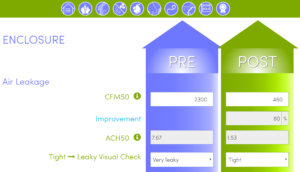Advancing Home Performance Data from the Stone Age to Modern Times
October 9, 2018
Debra Little, AjO
We in home performance care about homes. Beyond providing healthy, comfortable shelter for humans, our urgent goal for homes across the globe is their transformation to zero carbon emissions. Access and visibility of home performance data is vital to this progress.
In Redding, California, where it’s frequently 100-110 degrees in the summers, Mike McFarland built an impressively high performing house for his daughter and son-in-law. The 2,400 ft 2 house is heated and cooled with a ¾ ton heat pump. Now in their 13th month, they have the proof that heating the house required the kWh equivalent to $20 a year.
Mike has years of experience achieving significant measured savings. With this house, the performance was better than even he anticipated. The house is so efficient that the 5.3 kW solar system overproduced enough to fuel their annual commute (as soon as they buy that electric car)! How did these unexpectedly higher savings happen for such an experienced expert? As with any true creative, he’s constantly iterating, looking for ways to improve, pursuing excellence.
Mikes daughter’s house has a long list of impressive assets but no one will ever know about it. If he had a portfolio of 100 of these, chances are not many would know about it, unless he presents at a conference or an article is published. A challenge for us is that home performance data today is disconnected. Independent contractors, disconnected data dots. Because of disconnection, many who can use it to help drive demand are in a data drought.
Contractors are creating vital data. Those who measure their performance are creating higher-level data. But there’s room for maximizing its potential for their own use and others. Isn’t part of the pursuit of excellence and fulfillment in our work the joy of seeing it benefit not one house but many?
On the other side of the performance-focused coin, I recently met a resistant architect from Palo Alto, one of the most progressively green building cities in the United States. His complaint was about the escalating burden of paperwork, details required in plans, newly added inspections, and so on to meet increasingly high performance code requirements. This is a common and undoubtedly valid complaint. But he’s not connected to a feedback loop and is unaware of the prevalence of inadequate insulation and poorly designed and installed HVAC systems. He has no idea of the preponderance of these problems and apparently only a vague notion of the consequential waste of energy. This disconnection itself is a dominant problem; from designers to insulation installers, they don’t receive feedback on the final operational efficiency of their work. Part of the reason for these missing links is that there have been no handy tools to facilitate these connections. HPXML can expedite these tasks and increase utility and effectiveness of data.
HPXML facilitates the building of data connections, networks, and possibilities we’ve never had before. HPXML is a game-changer.
HPXML is the data standard and transfer protocol for the home performance industry. Standardization of terms is fundamental to clear, streamlined communication. Nothing new here, most industries collect data and use standardized terms, but it’s new to home performance. When HPXML is the language spoken by all stakeholders, instead of a chaotic babble of various terms and formats, less time will be required for expensive data management and more can be spent on productive progress. Our tools of communication should be effortless, not a barrier.
Consumption data is what we often call for but as central as it is, it’s not enough as a solo. It doesn’t explain the important question of why. Why is this house saving energy as a result of the installed scope of work? Project details data is crucial to inform us about what’s working where and why. As we’re hustling to save our periled planet, we need to know the most effective and efficient route to safety. HPXML speeds and enhances the drawing and dispersion of our essential maps to direct our work.
Energy Efficiency as a Grid Resource
Early this Spring I was hiking down California’s central coast. As I climbed up around a high point, I looked out to see Diablo Canyon nuclear power plant. This is a success story for us; because of advances in energy efficiency California is closing its last nuclear power plant.
Energy efficiency is gaining position as a reliable, low risk, lower cost, source of energy. I see this as a great hope for home performance and the planet. But like Rodney Dangerfield, the value of energy efficiency deserves more respect than it gets. For energy efficiency to be broadly recognized as a resource we still have work to do and our project details data is vital to this progress.
When grid resource and policy planners have reliable data they can bank on, we can expect to see increased funding for home performance. The emerging Pay-for-Performance programs exemplify movement in this direction. When policy creates opportunities for our experts to be paid based on energy savings, those who have a solid, data-grounded track record will be in a stronger position to take on such projects and to be paid more than ever. Much of this is about managing risk. Those who apply to participate must have confidence in their capacity to deliver. To win a contract they may be asked to not only provide proof of historical energy savings but also make the case as to why their proposed plans will succeed.

Builders who have a portfolio of high performance homes with proven energy and carbon reductions should be able to, with a push of a button, produce a report that delineates the level of detail requested to validate their work. To submit proposals, report performance, to communicate internally and with clients.
As the number grows of groups of buildings/homes with reliable, trackable results, energy efficiency can be more readily recognized and counted in grid power planning. Funds will be directed to support those scopes of work with proof of savings and minimal risk.
The more proof the less risk. With more accurate reporting, higher quality information will assist policymakers and investors in identifying opportunities to address existing problems as we’ve seen with Portland’s ubiquitous lack of insulation and Berkeley’s gas wall furnaces.
HPXML accelerates the creation and management of inspections, plans, reviews, approvals and post-project tracking. Data collection and exchange can be a more streamlined process to better support energy efficiency as a grid resource.
Valuation of High Performance Homes
Another problem that’s prevalent but could be solved with easier data access is around appraised value. Mike’s daughter didn’t escape this all too common problem. When they went for financing the appraiser and lender did not recognize any added value for the home’s performance assets.
Brian and Kathy in Grass Valley, California, met the same problem. They energy upgraded their 1960’s Ranch-style home to save 56% energy, then added solar to attain net zero. But again, the appraiser recognized no contributed value from these improvements.
The resistance of real estate appraisers and agents can be frustrating to homeowners and builders investing in high performance. This is a barrier to market uptake; they deserve the certainty that their investments will pay off. Yes, real estate pros need training, but we have yet to deliver them much data.
Appraisers need to understand the scope of work. What assets were installed and their benefits to house and occupants. What’s the difference between the pre and post of an energy upgrade? What sets this house apart from others? Documentation is key and here’s where we can do our part. We’ll be making progress when we provide data to homeowners and real estate professionals that’s clear, concise and standardized.

When we ask contractors to share their data what are we asking of our team? We can’t expect them to spend more time here. If we hand appraisers a stack of documents, they aren’t paid enough to spend extra time attempting to understand complex scopes of work. This needs to be a speedy process for all.
HPXML enables innovators to develop data tools to expedite documentation and support transparency.
We’ve seen success with mandated disclosure and I’ve come to believe that it’s (unfortunately) necessary to spark the action required in the timeframe our planet is calling for. With current resistance from so many factions, to wait for market driven outcomes will take too long. To mandate disclosure of energy use in listings at the time of sale and rental postings will ignite conversations, spur questions and change mind-sets around what’s important in choosing a home. Naturally, along with operating costs, questions will be asked about project details. Why does this house perform well and cost less to own? What benefits beyond efficiency do these assets deliver? We need to make this data available in a way that’s comprehensive yet effortless.
Let’s create a searchable, visually mapped database so our stories of what’s working where, can be more accessible. A national map of homes with energy upgrades and/ or renewables would be a compelling illustration of market activity to affirm value and the good work our home performance experts are accomplishing. It would be just one of many impactful solutions that HPXML can facilitate.
The telephone was a colossal leap from the Pony Express and now we have smartphones. Now HPXML advances by light-years, the capacity and efficiency of our data communications.
Today, several fires are raging here in California, again. After last year’s horrific fires in Santa Rosa and other areas, thousands more people are losing their homes. More housing will need to be rebuilt with urgency. As we rally to rescue and provide shelter for these, it’s essential that guidance be as accessible as a Google search for local coffee shops. The most direct routes to building efficient, cost-effective, resilient homes.
I love that home performance serves humankind through such a personal essential, our homes. In developing AjO, I saw a way I could support our experts with a handy data tool to communicate the benefits of their work more effectively and realize higher potential of their hard-earned data. So they might resonate even better with homeowners and inform efforts to reduce carbon and drive demand.
No more dilly-dallying in funky jalopies on rough, rutted roads. HPXML, like a bullet train, is a giant step into modern times. Every home performance contractor, software and program should utilize HPXML. Higher visibility of our data and stories is crucial to catalyze homeowners and accelerate progress to carbon-free homes and care for our wondrous planet.
Debra Little is a home performance and valuation specialist and creator of AjO, an HPXML data tool. With AjO, it’s fast and easy to describe energy upgrades in existing or new homes. AjO’s One Page Report is a concise “List of Ingredients” for homes. AjO can be used now for single family and is near ready for multifamily homes. Go to www.AjOhp.org